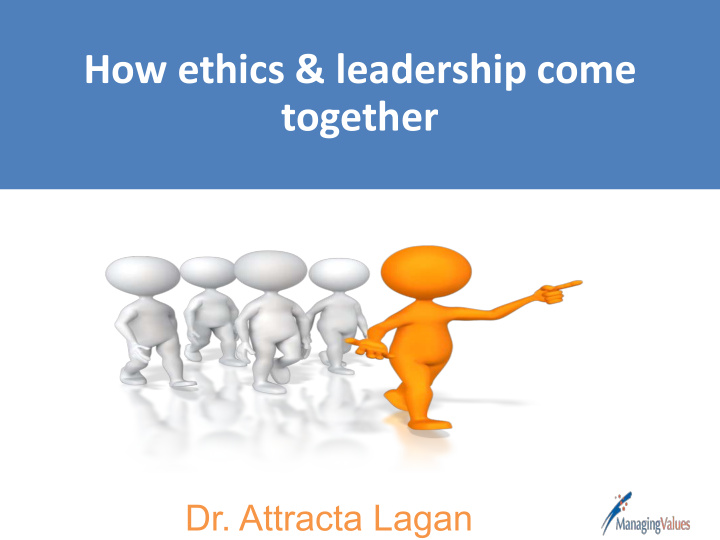



How ethics & leadership come together Dr. Attracta Lagan
CHALLENGING MINDSETS FOCUS TODAY ORGANISATIONAL CULTURE DESIGN - A MATTER OF CHOICE? BEHAVIOUR SCIENCE INSIGHTS MAKING IT EASY FOR EMPLOYEES TO BE ETHICAL WHAT GOOD LOOKS LIKE
CHOOSING TO BUILD ETHICAL CULTURE Reactive Proactive Buildi ding ng et ethi hical Reacting to awarene eness ss & skills t s to ethical/legal anticipate a and respond t to k known dilemmas Individual risks ks Short termism Purpose Organisation Unplanned culture Enabling culture design Measurement Compliance Ethical leadership Inward focus
“On show” world = Power Shift DIGITAL WORLD PRE-DIGITAL •DISTRIBUTED •INSTITUTIONAL •TRANSPARENT •OPAQUE •INCLUSIVE •CLOSED •DECENTRALISED •CENTRALISED •ACCOUNTABLE •LICENSED •BOTTOM UP •TOP DOWN 4
Where are you starting from? • Unethical behaviour is rarely a conscious decision • We can predict where and when people will misbehave Agree Disagree • Context is more important than character in workplace decisions • Amoral rather than unethical behaviour shapes culture • Going along to get along, is a leadership challenge?
BEHAVIOUR SCIENCE
None of us are as We are ethical as we think! emotional • Hu Humans a are e drive ven by emot otion ions; w we change o e our t thinking to g to j justify o our social beh ehaviour • The e contex ext is s a a greater ter influen ence e on beings, not behaviour than an c char arac acter • A leader ers r role e is to to alt alter always environments in way ays that m t make it it easy y for or p peop ople to to be e values es-drive ven rational… • Culture e either er drive ves or or dra rains mem ember ers’ e ener ergy gy and mot otiv ivatio ion
We Change Our Thinking To Justify Our Behaviour Unethical Cultural Behaviors Personal Predispositions Contextual Enablers Provide consistency, order and that • Change churn • Rationalisations emerges • Contextual pressures • Disengagement • Poor design/overwork • Low Skills • References from past • Diffused responsibility • Hierarchy • Payback • One way communications • Amoral managers • Compliance Focus • Inward focus • Absence of consequences
Everyone else is : fMRI scans show the part of our brain which makes moral judgements is less active when we’re in a group It’s not fair : when we feel wronged, we’re more likely to lie, cheat and steal We’re tired or emotional : decisions taken in We also the heat of the moment tend to be less know why ethical good It’s a slippery slope : when we deceive even slightly, we make it easier to do so again people Loyalty wins : we condone unethical behave behavior in people who’ve done us a favour unethically The consequences are severe : when the penalty for missing a target seems unbearable, we’re much more likely to break the rules to achieve it
How we rationalise unethical behaviour Denial of responsibility- “I know this is wrong, but I am only following orders” Denial of injury - “I know this is wrong, but no one is hurt” Denial of victim – “I know this is wrong, but s/he will never know” Social weighting - “I know this is wrong, but others do even worse things.” Appeal to higher loyalties- “I know this is wrong, but X is depending on me to get things done.” The metaphor of the ledger - “I know this is wrong, but I am underpaid and deserve this extra
Designing cultures of choice Recognise the context creates bounded ethicality • Training to forewarn and forearm • Use choice architecture • Nudges remind or warn people about behaviour choices • Priming - increase choice timely information • Frames need to be challenged to avoid ethical blind spots
The pathway to behaviour change Level of engagement Feedback & Do Reinforcement “I am making it happen & it’s the norm” Skill Development for action Feel “I believe in it; I feel it’s right” Acceptance Think Understanding “I understand the rationale” Unawareness Process of engaging people’s head, heart and actions
How do ethics & leadership come together? Higher Purpose - What is right & worthwhile Tone at the top & direction Conscious Leadership – “How” & “why” - Fair and just management Conscious Culture – Context designed “Listening culture” facilitating ethical behaviour Role Modelling – How leaders get others to behave ethically Measurement & Accountability behaviour standards
Recommend
More recommend